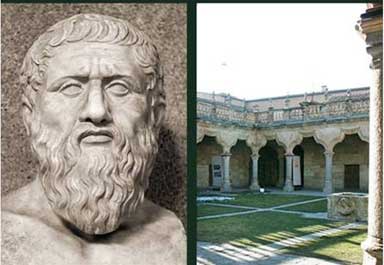Historical accounts indicate that many overseas pilgrims, including I-Tsing, Wu-Hing spent many years in Srivijaya, preparing for further studies in Nalanda or other seats of learning in India. I-Tsing himself stayed in Srivijaya for 10 years. Some scholars pursued their studies in Srivijaya, then returned and taught in India as well as other places, such as Dipamkara Shrijnana. There were also many Indian teachers who came and taught in Srivijaya, such as Sakyakirti, Vajrabodhi, and Amogavajra. And vice versa, many Indonesian masters and students who went to India and upon completion of the studies returned to Srivijaya to teach the knowledge acquired. One of the great teachers in Srivijaya who was renowned in the 10th /11th CE was Acharya Dharmakirti.
Acharya Dharmakirti
Acharya Dharmakirti was considered the greatest Buddhist scholar of his era. Six works in the Tibetan Tengyur that are definitely attributed to Acharya Dharmakirti include: (1) Abhisamaya-alamkara-nama-prjnaparmita-upadesa-sastra-vrtti-durbodha-aloka-nama-tika, (2) Bodhisattva-caryavatara-pindartha, (3) Bodhisattva-carya-vatara-sattrimsat- pindarta, (4) Siksa-samuccaya-abhisamaya-nama, (5) Arya-acala-sadhana-nama, and (6) Krodha-ganapati-sadhana [Alaka Chattopadhyaya (1999): Atisa and Tibet].
The Abhisamaya-alamkara-nama-prjnaparmita-upadesa-sastra-vrtti-durbodha-aloka-nama-tika appears to be the magnus opus of Dharmakirti: “… It is a stupendous work on Mahayana philosophy, devoted mainly to the clear exposition of the highest paramita conceived by the Mahayanists, namely the prajnaparamita … From this work alone, Dharmakirti can be considered as the most outstanding representative of the Mahayana philosophy of the 10th-11th century” [Alaka Chattopadhyaya (1999): Atisa and Tibet].
In the Peking edition of the Tengyur, the colophon reads as follows: “Written by Dharmakirti on the request of king Sri Cudamanivarman, during the tenth year of the reign of king Cudamanivarman, in Vijayanagara of Suvarnadvipa”. In Cordier’s Catalogue, the author of the text is mentioned as Acharya Dharmakirti-sri of Suvarnadvipa and it is added: “The work was composed during the reign of Deva-sri-varma-raja, the Cudamani, alias Cudamanimandapa in Malayagiri in Vijayanagara of Suvarnadvipa” [Alaka Chattopadhyaya (1999): Atisa and Tibet].
One of Acharya Dharmakirti’s foremost and most influential disciples was Dipamkara Shrijnana, who arrived in Indonesia in 1012 CE and studied in Srivijaya, or more precisely, in Muarajambi, for 12 years. He subsequently spread the teachings in India and Tibet, where it flourished extensively. Later in the 18th century during the reign of the Qing dynasty, those teaching became the national religion of the whole empire.
Dipamkara Shrijnana (980-1054 CE)
Dipamkara Shrijnana was born in a royal family in 980 CE in Bengal, Bangladesh. He was named Chandragarbha. At the age of 19, he was formally ordained, prabrajya, as a sramanera and was named Dipamkara Shrijnana. At the age of 29, he was fully ordained as a monk.
Dipa means ‘lamp’, kara means ‘one who does’; Dipamkara means ‘holder of the lamp’. Shrijnana means ‘shining wisdom’. In Tibet, Dipamkara Shrijnana is known as Lama Atisha. ‘Lama’ means ‘teacher’, whereas ‘ati’ refer to ’great, super’ and ‘Isha’ is ‘Lord’ or ‘prabhu’. Therefore, the meaning of Atisha closely resembles that of ‘maha-prabhu’.
At the age of 32, Dipamkara Shrijnana, together with a group of gemstone merchants travelled to Suvarnadvipa, which was the foremost learning center of Buddhism of its day.
Dipamkara Shrijnana spent twelve years in Suvarnadvipa studying under Acharya Dharmakirti, and apparently it was during this period that he became a master of the Mahayana teachings and logic. Acharya Dipamkara Shrijnana became one of the most famous alumni from Suvarnadvipa. Dipamkara sailed back for India in 1025.
Bodhi-patha-pradipa
Upon returned to India, Dipamkara Shrijnana taught at Nalanda and many others monasteries. He stayed in India for 15 years and at later stage, he served as director and academic head of Vikramashila monastery. He was requested to teach in Tibet. Initially he agreed to go to Tibet only for 3 years, but his stay was extended for 13 years until his death in 1054. During in Tibet, he summarized all the teachings and composed “Bodhi-patha-pradipa (Lamp on the Path to Enlightenment)” that really has lasting impacts. This rather concise teaching of only 66 stanzas (slokas) communicated in simple lucid language the basic principles of Buddhist thoughts. Bodhi-patha-pradipa later becomes the foundation for the work of “Stages on the Path to Enlightenment (Margakrama)”. He exercised the most profound influence in the religious history of Tibet, and later on until the present day of the Buddhist world at large. It is one of the most influential universal Buddhist teachings in the world, even today.
Sometime in mid 18th century, Changkya Rolpe Dorje (1717-1786), who expounded the teachings of the Great Lama Atisha Dipamkara Shrijnana and Master Tsongkha-pa, translated them into Manchu, Chinese, and Mongolian. One of his fellow students was the fourth son of the Yung Cheng Emperor of China, who became a close friend and later became the Emperor Ch’ien-lung. This friendship became the key to Changkya’s tremendous influence in China, Manchuria, Mongolia, and Tibet. He was invested with the same imperial privileges and titles that his previous incarnation had held – Teacher of the Empire. Thus, by age seventeen he had assumed a considerable role. Later, the Emperor appointed him the Lama of the Seal, the highest position for a Tibetan lama in the Chinese court. And Buddhism was made the national religion of the whole Chinese Empire at that time.
Therefore, the teachings that originate from Indonesia and were primarily brought into Tibet by Acharya Dipamkara Shrijnana and subsequently by his disciples are at present still widely taught, studied and practiced by many people all over the world.
Atisha Dipamkara Shrijnana acknowledged that he had many teachers but always mentioned that his main Guru from whom he received the most important teachings was Lama Serlingpa Dharmakirti Shri from Suvarnadvipa, Indonesia.
 Bahasa
Bahasa
 October 24th, 2010
October 24th, 2010  SUDIMUJA
SUDIMUJA 